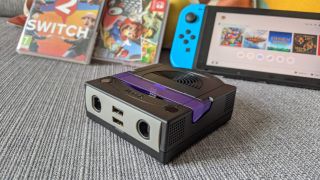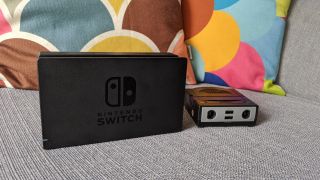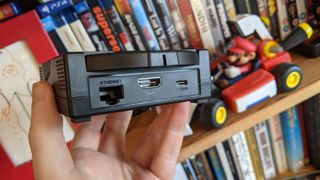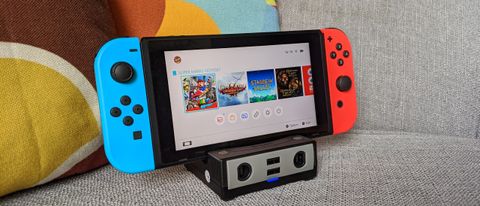TechRadar Verdict
Offering more features than even the official Nintendo Switch Dock, and with the promise it won’t brick your system like some third-party docks, the Brook Power Bay is worth picking up.
Pros
- +
Built-in GameCube ports
- +
Two-device Bluetooth audio support
- +
Affordable and safe
Cons
- -
No included power supply
- -
Power connector feels wobbly
- -
Would actually be better if bigger!
Why you can trust TechRadar
One Minute Review
The Nintendo Switch, with its hybrid on-the-go and in-the-home play styles, has been a huge success. But actually getting hold of Nintendo’s own accessories can be difficult, either due to stock or the high premium pricing that Nintendo’s gadgets command. In the case of the Nintendo Switch’s dock unit, it even feels as if it’s lacking in a few features – namely wireless headset audio support.
Enter gaming accessory maker Brook, and its delightful Brook Power Bay Nintendo Switch dock offering. Looking like a shrunken down Nintendo GameCube console, it’s an affordable alternative to Nintendo’s official Switch dock, and throws in a couple of nifty extras too.

Not only can it charge your console and output its video over HDMI to a big screen TV (doing all this safely without fear of bricking your console like some similar alternatives fall foul of), the Brook Power Bay also offers two built-in GameCube controller ports for Super Smash Bros. fans, support for Bluetooth headset audio, and mains-powered play when away from a TV, too.
It may not have Nintendo’s seal of approval, and can feel a bit plasticky in the hand, but with a lower price tag and a wider feature list, we’ve fallen in love with it.
Price and availability
The Brook Power Bay is available now and costs $50 (about £38), while the Bluetooth-less Crimson edition is slightly cheaper at $40 (around £30). Depending on where you buy it (and if you can find one in stock) an official Nintendo Switch dock will cost you double that.
While its finish isn’t as premium as Nintendo’s own, the Brook Power Bay makes up for it with its wider feature set, and makes for a very worthy competitor to Nintendo’s own accessory.

Design
If you reminisce about the chunky fun box that was the Nintendo GameCube, you’re going to love the look of the Brook Power Bay. It looks just like the older Nintendo console, if it had been flattened down a bit, with the Brook Power Bay measuring just 80mm – half the length of a regular Nintendo Switch dock. It’s small enough to fit in a pocket, and even comes with a little GameCube-aping detachable carry handle that can be popped onto the underside of the Power Bay to adjust the angle that your docked Switch sits at.
Once you’ve got a HDMI lead and a power supply plugged into the back of the Brook Power Bay (note it doesn’t come with a charging mains unit – part of the cost saving on show here), it’ll work just like a regular dock. Slot your console in under the purple plastic leanback flap, and it’ll beam the Switch’s screen up onto your TV, while charging it at the same time. Providing you use an official Nintendo power supply for the Switch, Brook promises that its dock will not cause any dangerous power fluctuations that some other third-party Switch docks fall foul of – the type that could potentially brick your prized portable. Like the official dock, the Brook Power Bay constantly alters its voltage supply based on what your console needs, ensuring it doesn’t fizzle up and burn out.

It’s around the front where the Brook Power Bay starts to come into its own though. Not only does it offer two easily accessible USB ports, but there are two built-in GameCube controller slots too. It’s not quite plug-and-play as you must hold a button down on the left hand side of the dock to ensure they’re recognized as the GameCube pad and not a regular Switch pad, and the button mapping issues that brings with it, but it’s a minor complaint for a feature that would otherwise only be accessible by an additional adaptor. [Brook informs me that a forthcoming firmware update will address this issue in the coming days, making for a true plug-and-play experience, but that wasn’t ready in time for this review.] For Smash Bros. players, it almost makes it worth the purchase alone, given their die-hard preference to the earlier control pad.
Another boon over the official dock is the much-missed Bluetooth audio support. With the Brook Power Bay you’re able to hook up two Bluetooth audio devices for wireless audio from your sofa, without the need for an additional Bluetooth adapter of losing one of the dock’s USB ports. Using the Qualcomm CSR SoC, there’s no obvious latency introduced, making for seamless wirefree listening.

Though its portable size will be welcomed by on-the-go gamers, we’d have actually appreciated a little more weight and heft to the Brook Power Bay. If you’ve got stiff cables coming out the back of your dock, you might find that they push the lightweight Power Bay off a level surface, which could cause instability for your Switch. Likewise, you’re going to have to carefully direct your Switch’s charging port into the Brook Power Bay’s connector (which moves around a little bit to accommodate different leaning angles), as it doesn’t have the deep gully they official dock has, which makes it so easy to safely navigate into the charging position. It’s that rare occasion where a portable accessory would actually benefit from being a little bigger.

A cheaper red model, the Power Bay Crimson is also available, and does all of the above but drops Bluetooth support.
Performance
The Brook Power Bay works a treat. It lacks the premium feel of Nintendo’s console, and the snug fit of its larger dock, but what it lacks in polish it makes up for in functionality. All its advertised features worked incredibly well, and while some elements are a bit fiddly – like getting the GameCube controllers recognized, and guiding the Switch onto the power point – they’re small issues given the overall value offered here. Sure, you’ll have to find supply your own power unit, but you could well find this replacing your official dock, given how much more feature-rich the Brook Power Bay proves to be.

The more I used it, the more I discovered it had a few hidden features too.
Remove the HDMI lead from the back of the Brook Power Bay, but leave it powered on, and you can then use the Switch with its own screen powered on while standing in the dock, without losing the Brook Power Bay’s other useful features. This actually also makes it useful to Nintendo Switch Lite owners, as they can use it as a powered stand even if they can’t make use of its HDMI video output settings.
The dock has one final trick up its sleeve, too. If you’re rocking a mobile device that has a USB-C port, and can support DP Alt-Mode to carry video data over that USB-C connection, the dock will also output video from that device too. Just plug your phone into the slot, and it’ll automatically mirror its output onto a big screen. It’s a handy extra feature, adding further value to an already value-adding package.
Brook Power Bay Ethernet Switch Dock: A new challenger approaches
Since the release of the original Brook Power Bay Switch Dock, the company has put out a revised edition of the Switch accessory which introduces an Ethernet port to the rear of the design.

The Brook Power Bay Ethernet Switch Dock is otherwise all-but identical to its predecessor, again including a dock slot, two USB ports and the all-important built in GameCube ports. It's purpose really is to lower ping in online matches – if you're a big Switch online gamer, having a stable connection is important, something that the Wi-Fi only standard Switch and Dock can at times struggle with. Brook's alternative offers complete stability over its hardwired connection, providing your console is in a position to run an Ethernet cable to it.
At present, the Brook Power Bay Ethernet Switch Dock isn't on widespread release. We've been playing around with a prototype model, but can confirm it's every bit as good as the original device. Expect to see this edition on sale by April 2021 – and we'll have full pricing and availability details to share when it goes on general sale.
Buy it if...
You love playing Smash Bros. with a GameCube pad
The Brook Power Bay makes plugging in the retro controllers and using them a piece of cake, removing the need for an additional accessory.
The convenience of wireless audio appeals
One-upping the official Nintendo Switch dock, the Brook Power Bay offers Bluetooth audio connectivity right out of the box.
You’re on a budget
The Brook Power Bay, despite its wider array of features, costs close to half the amount of the official alternative.
Don't buy it if...
You still fear third-party dock bricking horror stories
Brook has done all it can to protect your Switch from power surges, but as an unofficial accessory, it doesn’t come with Nintendo’s seal of approval.
You have trouble docking your Switch
… as it won’t be easier here. The Brook Power Bay takes some finessing in order to get your console lined up perfectly with its power port.
You haven’t got the money for an official Nintendo power supply
There’s no power supply in the box here, so unless you’ve got a spare Switch one handy, or are prepared to swap out your existing console dock’s one, you’ll need to purchase another.
- Best Nintendo Switch games: the best titles to show off the Power Bay with
Gerald is Editor-in-Chief of iMore.com. Previously he was the Executive Editor for TechRadar, taking care of the site's home cinema, gaming, smart home, entertainment and audio output. He loves gaming, but don't expect him to play with you unless your console is hooked up to a 4K HDR screen and a 7.1 surround system. Before TechRadar, Gerald was Editor of Gizmodo UK. He is also the author of 'Get Technology: Upgrade Your Future', published by Aurum Press.


